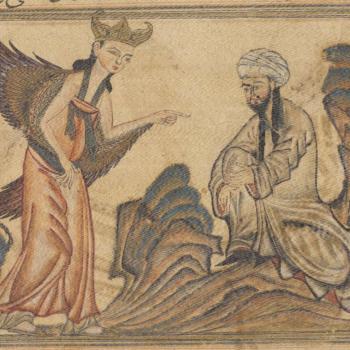The first paper in the second session at the York Christian Apocrypha Symposium was by Brent Landau, focused on the Revelation of the Magi. In that text, Christ himself is the star that leads the magi, and he multiplies their food. When they and others eat that food, they experience visions of Christ. Landau suggests that this reflects practices and religious experiences of Christians in the time when Revelation of the Magi (RM) was composed. He suggests that a hallucinogen was probably ingested – and he notes the fact that some others have suggested the use of hallucinogens by reading between the lines in problematic ways, while this text is quite explicit. The narrative is very rich, and so how does one tell if real religious practices are in view? Landau cites Jim Davila’s work on the subject, and the criteria he delineates. Landau suggests that the details of the narrative may be fantastic, but the ritual elements – purification, prayer, and reading texts thought to stem from Seth the son of Adam – may correspond to what some Christians actually did. The magi have visions under the influence of the star, apart from food, but the food (always called “provisions”) which was exposed to the star’s influence enables others to have visions. RM fits at least two of the three criteria he has taken over from Davila. The third is less clear: RM does echo stories of multiplication of food in the Bible, and the ingesting of scrolls by prophets, but there is no explicit connection between eating and visions. IV Ezra and Joseph and Aseneth also hint that the consumption of certain substances may lead to visions, but it is not explicit as it is in RM. Indeed, this would be the only explicit reference to hallucinogensin ancient Jewish or Christian literature. This does not indicate that the work was written under the influence of such substances. How much can cross cultural study tell us about what they might have done? A Mazdean parallel may exist in haoma, but that was a drink. RM actually does not present the magi as Zoroastrian priests, but as descendants of Seth. Their name as magi is said to refer to their practice of silent prayer. And so if anything, RM downplays Zoroastrian connections. A commenter referred to Meredith Warren’s work on transformational eating (her book My Flesh Is Meat Indeed, and she also has an article on IV Ezra). D. C. A. Hillman’s The Chemical Muse was also mentioned. Anne Moore mentioned the Dura Europos baptistry, where the art reflects the ritual, including following the women and being greeted by Jesus, creating an experience. Do visionary accounts tie in to such evidence? Do they eliminate the need to posit ingestion of a hallucinogenic? Other psychotropic practices (sleep deprivation, wine consumption, etc.) are also relevant.
Pierluigi Piovanelli offered the second presentation in this session, looking at the Acts of Paul, Apocalypse of Paul, and the Zohar as examples of pseudepigraphy in which the works were said to be forgeries in antiquity. In Tertullian’s On Baptism there may be reference to a Cainite sect (the reading varies across the manuscript tradition). Jerome’s Lives of Illustrous Men adds that the forger of the Acts of Thecla was convicted of forgery before the apostle John. Piovanelli asked whether we can trust someone like Tertullian, who would have assumed that any work promoting women in ministry was a forgery. He also mentioned a new book, The Gospel according to Renan, which provides evidence of how opponents will invent accusations and these may be embraced by others uncritically, despite there not being adequate evidence for them. See also Abraham Zacuto’s account in Sefer Yuhasin of the confession of Moses de Leon’s wife about his forgery of the text, and the acceptance of this by anti-kabbalists and others. Piovanelli quoted Gershom Scholem’s Major Trends in Jewish Mysticism, which comments on pseudepigraphy and the need to distinguish it from forgery, the historian of religion not needing to join in the condemnations that theologians are prone to, or at least not in the same ways or for the same reasons. Bart Ehrman asked for clarification about whether ancient pseudepigraphers intended to deceive. Piovanelli replied by making reference to Jack Goody about actualization and rewriting. Reference was made to Philip Jenkins’ forthcoming book The Many Faces of Christ. Ehrman and Piovanelli articulated their disagreements about the categorization of the Book of Acts, and whether the “we passages” are a historiographical device attempting to evoke emotion, or represent an attempt to deceive readers.

















